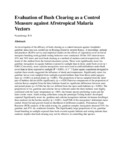| dc.contributor.author | Nyanchongi, B O | |
| dc.date.accessioned | 2013-03-01T15:55:11Z | |
| dc.date.available | 2013-03-01T15:55:11Z | |
| dc.date.issued | 2005-09 | |
| dc.identifier.uri | http://erepository.uonbi.ac.ke:8080/xmlui/handle/123456789/13209 | |
| dc.description | M.Sc. Applied Parasitology | en |
| dc.description.abstract | An investigation of the efficacy of bush clearing as a control measure against Anopheles
gamb/ae sensu lata was carried out on Rusinga Island in western Kenya. A knowledge. attitude and practices (KAPs) survey and empirical studies on the effects of vegetation cover
on larval mosquito breeding ecology/adult resting behavior were conducted. Of the 1451 interviewees 43% and 34% knew and used bush clearing as a method of malaria control respectively. 69% learnt of this method from the formal education system. There were significantly more An. gambiae mosquitoes in aquatic habitats exposed to sunlight than in those under bush cover (p < 0.001) Conversely. more culicine mosquitoes were recovered in artificial habitats under bush cover than in those exposed to sunlight (P < 0.001). A 3 " 3 Latin square experiment designed to explain these results suggested the influence of shade and temperature. Significantly more An. gambiae larvae were sampled from sunlight-exposed habitats than from those under papyrus mats (p < 0.001) or potted plants (p < 0.001). The proportion of larvae sampled from the latter pair of habitats did not differ significantly (p = o 028) Pairwise compansons of the proportion of culicine larvae sampled from the three habitats found no significant differences between mats and potted plants (p = 0.566) but the two differed from the open sunlit habitats (p < 0.001). The proportions of An. gambiae and culicine larvae collected under the three habitats were highly correlated with the water temperature (p < 005). the former species preferring warm and the latter cooler water. Adult resting collections usmq the prototype Testing basket' developed captured Significantly more An. gambiae and culicine mosquitoes indoors (in human dwellings) than outdoors (in the bushes nearby) \p < 0.001). AnalYSIS of the mosquitoes' abdominal status (unfed. blood fed and gravid) found no likelihood of deliberate exophily. Polymerase Chain Reaction (PCR) analysis of the adult resting An. gamb/ae complex mosquitoes detected 53% An. gambiae and 47% An. arabiensis females. The Significantly large proportions of An. gambiae found breeding in sunlight-exposed than bush covered aquatic habitats and resting indoors than outdoors implies that bush clearing may not be effective in controlling this species. | en |
| dc.language.iso | en | en |
| dc.subject | Afrotropical Malaria Vectors | en |
| dc.subject | Malaria Control Measures | en |
| dc.title | Evaluation of Bush Clearing as a Control Measure against Afrotropical Malaria Vectors | en |
| dc.type | Thesis | en |
| local.publisher | College of Biological and Physical Sciences | en |

